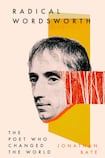
While it was Percy Shelley who argued that poets were the “unacknowledged legislators of the world”, William Wordsworth was the poet, according to Jonathan Bate, who actually transformed it.
After the publication of his joint collection with Samuel Taylor Coleridge, Lyrical Ballads (1798), a work greatly influenced by the French revolution, literature could finally be written in the language of ordinary men and women. Many mocked, and the volume did not sell especially well (Lord Byron’s Childe Harold shifted a lot more copies), but it demonstrated that poetry could engage with everyday life without becoming patronising or descending into bathos.
Wordsworth is famous as the poet of the English Lakes – his guide was his only real bestseller – and we owe him a great debt for helping to preserve this area of outstanding natural beauty. Indeed, Wordsworth’s influence spread much wider than northwest England: the driving force behind Yosemite National Park in California, John Muir, was inspired by his poetry.
For Prof Bate, one of the main reasons for reading Wordsworth now is because his poetry foresees the “consequences of modernity” and the “potentially irretrievable damage to the delicate balance between our species and our environment”.
Wordsworth is also important as the pioneering poet of the self, taking his own life and experiences as the subject of his poetry. His great autobiographical poem, The Prelude, first published in 1799 and revised in his old age (1850), charts the growth of the poet’s mind through his particular experiences. Wordsworth certainly did not lack ego, but his ability to communicate the moments that mattered to him in bold, direct and straightforward language make this long poem probably his greatest achievement.
Influenced by Coleridge’s careful and intense reading of continental philosophy, Wordsworth translated his friend’s abstract ideas into something much more accessible. He believed that all of us experience “spots of time”, moments of great intensity that can transform our lives if only we understand their significance.
They need not be especially major events in our lives: Wordsworth recounts a pantheistic vision while ice skating on Lake Grasmere as a boy, and experiencing the sublime power of nature as he descended the Simplon Pass in Switzerland. However, we need to recognize them when they occur and understand why they matter and what they tell us.
As Prof Bate points out in this excellent and enjoyable study, Wordsworth had a great decade (1796-1806) when he wrote virtually everything that is worth reading. His final 40-odd years (1807-50) contain little of value and his tinkering with his earlier works, such as The Prelude, hardly ever results in better poetry.
His major creative phase coincided with his friendship with Coleridge; when they fell out and went their separate ways, the work of both suffered.
Coleridge was as self-centred as Wordsworth. An overweight drug addict who was given to impractical enthusiasms and plans, always running out of money and dependent on the charity of others, he was hardly an ideal house guest. (It did not help that he was madly in love with Wordsworth’s sister-in-law.) He was an odd companion for the austere and emaciated Wordsworth, who was obsessed with walking the countryside at ferocious speed as an act of democratic sympathy with ordinary men and women.
Wordsworth did have other important friends and allies with whom he went walking, notably his loyal sister Dorothy, whose journal contains the notes on the bank of daffodils that William transformed into his most anthologised poem. Together the three of them formed an unstable but brilliant partnership that could never last, but which produced some of the most significant creative writing in English.
The balance of Wordsworth’s enthusiasms did not remain stable. A professed radical in his youth, he grew more reactionary as he aged, as well as more vain and opinionated, and vulnerable to satire.
If one response to the upheavals of the events of the 1790s was to become ever more eager to expose the hypocrisies of the establishment, as in the extreme case of the Marquis de Sade, the other was to follow Wordsworth’s path and believe that “the ills of society were better addressed by a nature cure stimulated through poetry than by political measures to eradicate poverty and create equality”. Nature became a universal panacea.
For too long Wordsworth has been cast as a poet who is significant but worthy, a writer whose work cannot be ignored but is not often enjoyed. If we accept that he wrote a large amount of ordinary poetry we should also acknowledge that his best work, The Lyrical Ballads, The Prelude and Tintern Abbey, repay close and frequent reading.
Radical Wordsworth is not a complete biography but takes its cue from Wordsworth’s own understanding of himself to concentrate on the “spots of time” that produced his great work.















